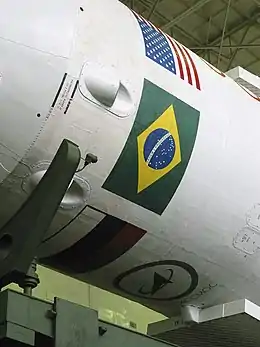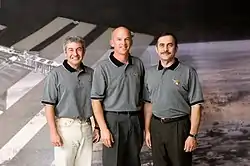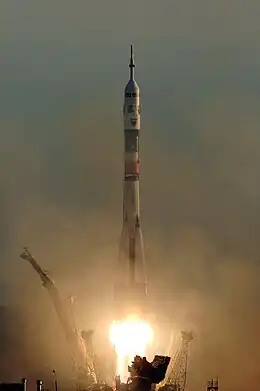 Brazilian flag at the side of the rocket. | |
| Mission type | Short duration flight |
|---|---|
| Mission duration | 9d 21h 16m |
| Orbits completed | 155 |
| Expedition | |
| Space station | International Space Station |
| Began | March 30, 2006, 02:30:20 UTC (17 years ago) |
| Ended | April 8, 2006, 23:47:12 UTC (17 years ago) |
| Arrived aboard | Soyuz TMA-8 |
| Departed aboard | Soyuz TMA-7 |
| Crew | |
| Crew size | 1 |
| Members | Marcos Pontes |
.png.webp)
 Marcos Pontes Visiting expeditions (pt) | |

The Missão Centenário was born of an agreement between the Brazilian Space Agency (AEB) and the Roscosmos on October 18, 2005. The main objective of this treaty would be to send the first Brazilian into space, Lt. Col. Aviator Marcos Pontes.[1]
The name of the mission is a reference to the commemoration of the centenary of the first crewed flight of a Brazilian-designed aircraft, the Santos-Dumont 14-bis, in Paris on October 23, 1906.
The vehicle used for launching the mission was the Roscosmos Soyuz TMA-8 spacecraft, and its launch took place on March 30, 2006 (11:30 p.m Brasília time) at the Baikonur Cosmodrome (Kazakhstan) to International Space Station (ISS).
Bilateral agreement for the mission
The Missão Centenário was made possible by an commercial agreement[2] signed in October 2005 between Brazil and Russia, with representatives of the Brazilian Space Agency (AEB) and Roscosmos.[3]
As a result, astronaut Marcos Cesar Pontes began training in Star City, a training center for cosmonauts near Moscow.[3]
Launch
The Soyuz TMA-8 spacecraft carrying Lieutenant Colonel Marcos Pontes was launched at 11:30 p.m. on March 30, 2006 (Brasília time, 8:30 p.m. in the morning of April 1, 2006 in Kazakhstan time) . Besides the Brazilian astronaut, the crew were the Russian Pavel Vinogradov and the American Jeffrey Williams, these two members of Expedition 13.[4]
When Pavel Vinagrodov hooked up the cabin video camera to Marcos Pontes during the launch, the Brazilian did not know what to say. He thought of waving, but that did not express what he felt, then he pointed to the flag and then up, meaning that they were all together, but he thought "wait a moment, pointing with one finger does not give the impression of 'together'!". So he pointed with two, as you can see in the video of the mission.[5] The spacecraft docked with the International Space Station (ISS) in the early hours of Saturday, April 1.
Prior to entry to the International Space Station, the international protocol included the following order: Pavel, Jeff and Marcos. But when Pavel noticed Marcos with the Brazilian flag in his hands, he told him to come in first. Marcos replied that they might have problems. To this, the Russian replied that it would not be Marcos who would be entering the front, but a whole nation, and neither he nor Jeff would have the right to enter before a nation.[6]
Experiments
Lt. Col. Marcos Pontes carried out eight scientific experiments at ISS, so that their behavior in a microgravity environment could be analyzed. Here are the experiments performed:[7][8]
| Name[9] | Type | Researcher | Ref. |
|---|---|---|---|
| Biomedical research | |||
| GOSUM | (Seed) Germination in Microgravity (EMBRAPA) | Dra. Antonieta Nassif Salomão. | [10][8] |
| Biotechnology research | |||
| DNARM | DNA Repair in Microgravity (UERJ and INPE) | Dr. Heitor Evangelista da Silva | [10][8] |
| SMEK | Microgravity enzyme kinetics (FEI) | Dr. Alessandro La Neve | [11][10][8] |
| NIP | Protein Interaction Clouds (CenPRA/MCT) | Dr. Aristides Pavani Filho | [10][8] |
| Engineering research | |||
| CEMEX | Capillary Evaporator in Microgravity (UFSC) | Dr. Edson Bazzo | [10][8] |
| WMHP | Miniature wire heat pipes (UFSC) | Dra. Márcia Barbosa Henriques Mantelli | [10][8] |
| Educational projects | |||
| SEEDS | Germination of common bean seeds (Secretaria Municipal de Educação de São José dos Campos-SP) | [10] | |
| CHROPHYL | Observation of the Chlorophyll Chromatography Process in Weightlessness (Secretaria Municipal de Educação de São José dos Campos-SP) | [10] | |
The educational experiments from the list above were accompanied by students from schools in São José dos Campos through the Internet, while conducting the same experiments on ground.[10]
Interviews
During his stay at ISS, Marcos Pontes conducted some interviews by video-conference.
On April 3, 2006, an interview was broadcast in honour of Santos Dumont, in which Marcos Pontes used a Panama hat like the inventor and a handkerchief with the acronym "SD".
Return
The Soyuz TMA-7 brought in the night of April 8, 2006, Brasilia time, the Ten. Col. Marcos Pontes and two other astronauts from Expedition 12 (Russian Valery Tokarev and American William McArthur) who were already on the ISS. The landing point was in Kazakhstan.[12]
For the rescue, 17 Russian MI-8 helicopters were used,[12] and the area of the landing was around the city Arclalic, within a radius of 60 to 80 km away from it.[13]
After the return, the three astronauts underwent a period of readaptation to gravity.[14]
Total duration of the mission
Marcos Pontes performed 155 orbits and the total duration of his mission was 9 days, 21 hours and 17 minutes.[4]
Patch
The patch of the Missão Centenário was produced jointly by Secom, MCT and AEB.[15]
Commemorative acts
As a celebration for this mission that was the first to bring a Brazilian astronaut into space, as well as being a tribute to the centenary of the first flight of an aircraft heavier than the air of Santos Dumont in Europe, stamps and a medal were released.[16]
Criticism
The mission was criticized by part the Brazilian scientific community, such as the Sociedade Brasileira para o Progresso da Ciência (SBPC), according to which the money invested in the mission should be used to train staff as well as investing in other types of scientific research. In addition, they report the non-compliance of the Brazilian participation in the construction of the ISS. Other critics denounced the political use and crossed out the trip as space tourism.[17][18][19]
The Brazilian Space Agency and Marcos Pontes rebuffed these criticisms, saying that the space program has never had so much visibility in the press, which would make it possible in the future to allocate more funds for space exploration. In addition, the mission may encourage children to study and pursue a scientific career.[20]
Gallery
 Pontes signing the Baikonur Cosmodrome checkout hotel room, an Astronaut/Cosmonaut tradition
Pontes signing the Baikonur Cosmodrome checkout hotel room, an Astronaut/Cosmonaut tradition Marcos (center) with his crew members in the Soyuz factory
Marcos (center) with his crew members in the Soyuz factory Greeting guests while at Baikonur on launch day
Greeting guests while at Baikonur on launch day Train bringing the rocket to the launching area
Train bringing the rocket to the launching area Launch of Soyuz TMA-8 on March 30, 2006
Launch of Soyuz TMA-8 on March 30, 2006 Pontes inside the Soyuz during launch to the ISS
Pontes inside the Soyuz during launch to the ISS- ISS Conference
 Hatch opening
Hatch opening Soyuz TMA-7 leaving the Station with the Brazilian astronaut
Soyuz TMA-7 leaving the Station with the Brazilian astronaut President Lula during a video-conference with the Brazilian astronaut, Marcos Pontes.
President Lula during a video-conference with the Brazilian astronaut, Marcos Pontes. Crew from Soyuz TMA-7 after landing with Marcos Pontes
Crew from Soyuz TMA-7 after landing with Marcos Pontes Speech by Sergio Gaudenzi during the launch of commemorative stamp and medal.
Speech by Sergio Gaudenzi during the launch of commemorative stamp and medal. Launch of the Soyuz TMA-8 with Jeffrey Williams, Pavel Vinogradov and Marcos Pontes on March 30, 2006
Launch of the Soyuz TMA-8 with Jeffrey Williams, Pavel Vinogradov and Marcos Pontes on March 30, 2006
See also
References
- ↑ "Missão Centenário". Agência Espacial Brasileira. March 7, 2006. Archived from the original on March 31, 2006.
- ↑ "Space Station 20th – Space Flight Participants". 2020-04-30. Retrieved 2021-09-24.
- 1 2 "Brazil's President In Moscow Signs Deal For Joint Space Mission". October 18, 2005. Archived from the original on April 15, 2019. Retrieved April 3, 2020.
- 1 2 "Soyuz TMA-8".
- ↑ Pontes, Marcos (2011). Missão Cumprida: A História completa da primeira missão espacial brasileira [Mission Accomplished: The complete history of the first Brazilian crewed space mission] (in Brazilian Portuguese). Brazil: McHilliard. p. 266 and 267. ISBN 9788564213012.
- ↑ Pontes, Marcos (2011). Missão Cumprida: A História completa da primeira missão espacial brasileira [Mission Accomplished: The complete history of the first Brazilian crewed space mission] (in Brazilian Portuguese). Brazil: McHilliard. p. 285. ISBN 9788564213012.
- ↑ ISS: Expedition 13
- 1 2 3 4 5 6 7 "Desenvolver o Setor de Pesquisas em Microgravidade no Brasil" [Developing the Microgravity Research Sector in Brazil] (in Brazilian Portuguese). Archived from the original on April 3, 2020. Retrieved April 3, 2020.
- ↑ "Program of scientific experiments under the BSM CENTENARIO project". Retrieved 2021-08-08.
- 1 2 3 4 5 6 7 8 9 "Astronauta brasileiro fará 9 experimentos no espaço" [Brazilian astronaut will do 9 experiments in space] (in Brazilian Portuguese). December 20, 2005. Archived from the original on April 3, 2020. Retrieved April 3, 2020.
- ↑ "Astronauta brasileiro levará experimento da FEI para o espaço" [Brazilian astronaut will take FEI experiment into space] (in Brazilian Portuguese). December 23, 2005. Archived from the original on April 3, 2020. Retrieved April 3, 2020.
- 1 2 "Marcos Pontes conclui a primeira missão de um brasileiro no espaço" [Marcos Pontes concludes the first mission of a Brazilian in space] (in Brazilian Portuguese). April 9, 2006. Archived from the original on April 3, 2020. Retrieved April 3, 2020.
- ↑ "Soyuz TMA-7".
- ↑ "Astronauta só lamenta não ter jogado futebol na estação" [Astronaut only regrets not having played soccer at the station] (in Brazilian Portuguese). April 12, 2006. Archived from the original on April 3, 2020. Retrieved April 3, 2020.
- ↑ "Bolacha da missão espacial homenageia Centenário de Santos Dumont" [Patch of the space mission honors Santos Dumont Centenary]. 2006-01-18. Archived from the original on 2020-10-08. Retrieved 2020-10-08.
- ↑ "Viagem de Marcos Pontes ao espaço inspira criação de selos e medalhas" [Marcos Pontes' journey to space inspires creation of stamps and medals] (in Brazilian Portuguese). March 29, 2006. Archived from the original on April 3, 2020. Retrieved April 3, 2020.
- ↑ "G1 > Brasil - NOTÍCIAS - Brasil está fora do projeto da Estação Espacial (ISS)".
- ↑ Rohter, Larry (8 April 2006). "Brazil's Man in Space: A Mere 'Hitchhiker,' or a Hero?". The New York Times.
- ↑ "Notícia Online da BBC News". 30 March 2006. Retrieved March 12, 2008.
- ↑ "Marcos Pontes rebate críticas e defende missão brasileira" "07/04/2006"
External links
- "AEB investment in the Missão Centenário". Comparative table of costs between the Missão Centenáio and other investments and annual consumption in the country. Archived from the original on April 3, 2020. (in Portuguese)
- "Why spend on space exploration with so many people starving?". 28 November 2013. Archived from the original on April 3, 2020. (in Portuguese)